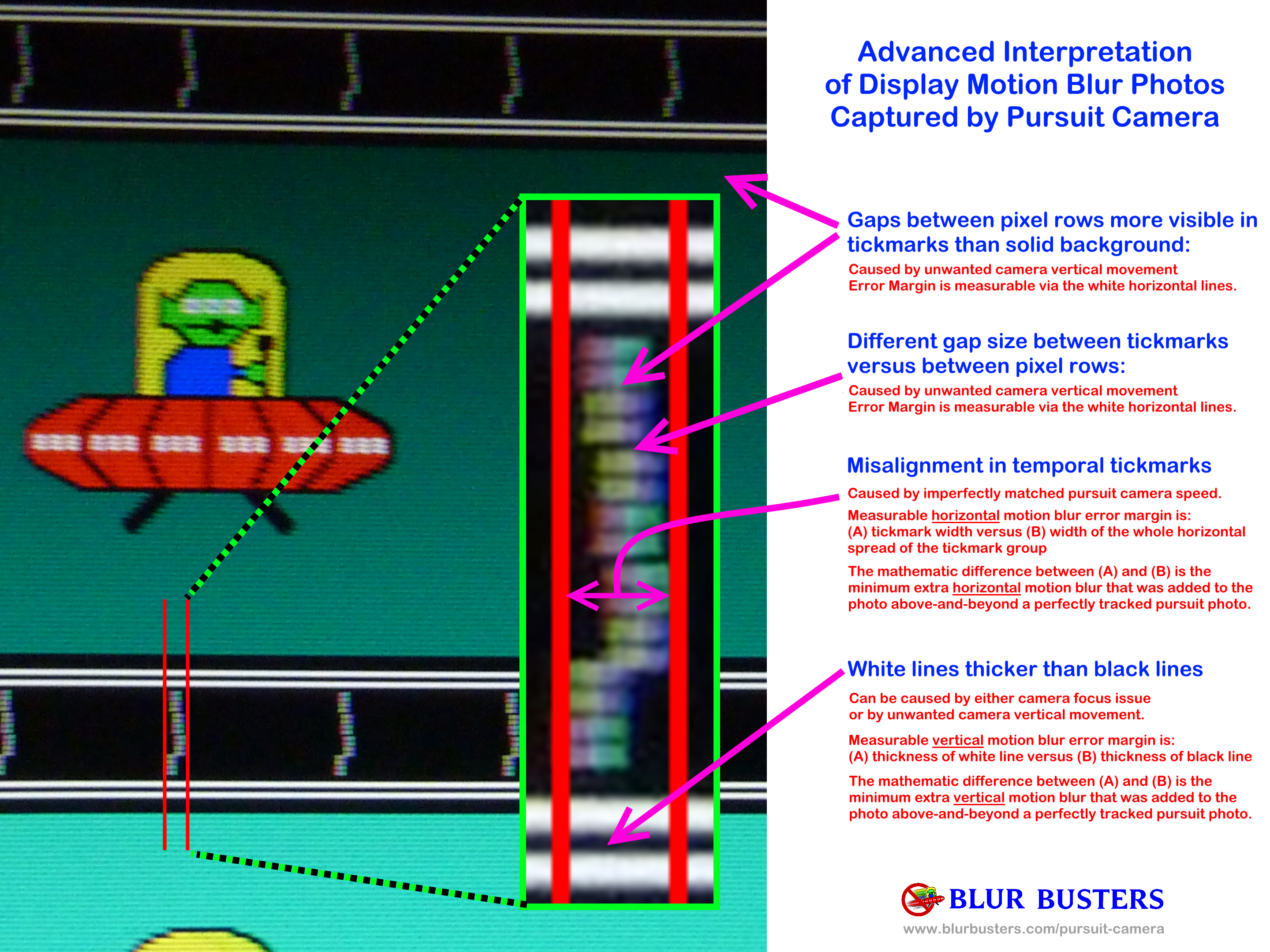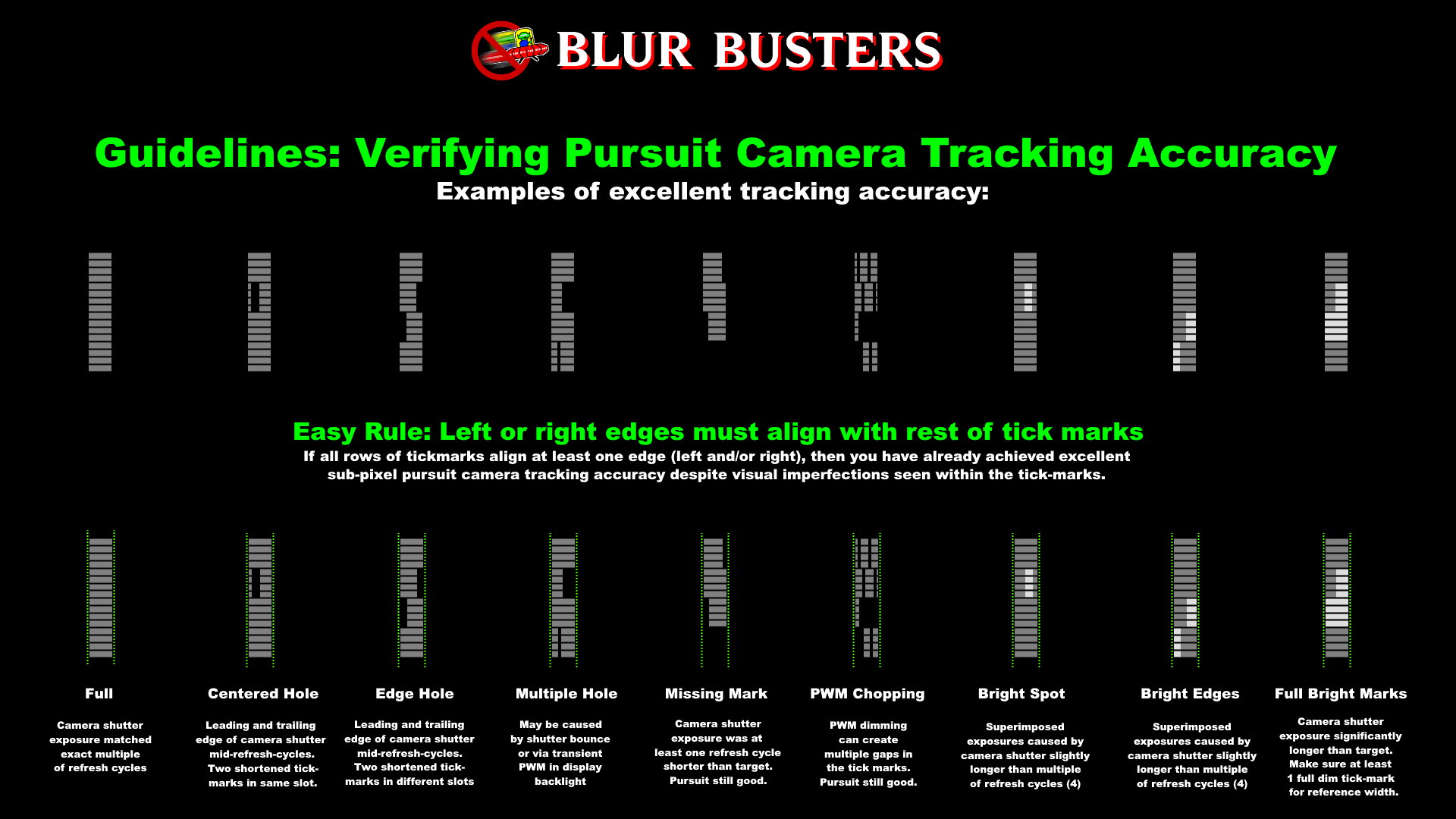Using a shutter speed of one-quarter of the refresh rate allows for accurate motion blur capture, but slower shutter speeds produce effects closer to real-world perception. When comparing motion blur on 60Hz, 120Hz, and 360Hz displays, should a uniform 1/15-second shutter speed be used, or should the shutter speed be adjusted differently for each case?
If perfect tracking is achievable, should all refresh rate displays use the slowest possible shutter speed?
The issue of Pursuit Camera With Motion Tests
Re: The issue of Pursuit Camera With Motion Tests
After I set up the test slider, all screens are tested with a shutter speed of 1/15s, right? This should be the fairest?
- Chief Blur Buster
- Site Admin
- Posts: 12077
- Joined: 05 Dec 2013, 15:44
- Location: Toronto / Hamilton, Ontario, Canada
- Contact:
Re: The issue of Pursuit Camera With Motion Tests
Hello,
Use a shutter speed of 4 refresh cycles. For 240Hz, that means 1/60sec. It's dictated by the design of the sync track. As long as you stack multiple refresh cycles, anything from 3 to 7 refresh cycles should look EXACTLY the same.
A properly done 1/30sec vs 1/60sec vs 1/45sec pursuit exposure at 240Hz should look exactly the same; but they look different because of photographer pursuit difficulty. Faster exposure is subject to less handshake/railvibrate/pursuit-mismatch error margins. So you get easier WSIWYG at faster exposure.
We have a pursuit camera forum, so I am moving the thread to the correct forum:
viewforum.php?f=23
- You don't have to use 4xHz always. For low Hz, you can use 3xHz, as long as you follow the guidelines (see diagrams posted in forum)
- We will be improving the sync track to allow tickcount adjustment (3xHz, 4xHz, 5xHz ... 8xHZ).
Currently we use a 4-tickout pursuit sync track, which makes it easiest at 4xHz, but 60Hz is very difficult at 1/15sec, so 3xHz is a compromise (1/20sec) to make it easier. Shorter exposures produces more reliable pursuit camera exposures that are easier to get closer to WYSIWYG.
Use these guidelines:


A 4-tick sync track is usable from 3 exposed refresh cycles (minimum) through 7 exosed refresh cycles (maximum), as long as you've become very good at interpreting the error margins in the sync track. A full 2x tickmark (8 refresh cycles) exposures can be confused by slowly-skewing bright tickmarks, giving you too many redherring effects.
TestUFO 3.0 will have an adjustable sync track and automatic helpers ("Exposure: 1/[##]sec") based on current tickmark count and automatically detected refresh rate.
Use a shutter speed of 4 refresh cycles. For 240Hz, that means 1/60sec. It's dictated by the design of the sync track. As long as you stack multiple refresh cycles, anything from 3 to 7 refresh cycles should look EXACTLY the same.
A properly done 1/30sec vs 1/60sec vs 1/45sec pursuit exposure at 240Hz should look exactly the same; but they look different because of photographer pursuit difficulty. Faster exposure is subject to less handshake/railvibrate/pursuit-mismatch error margins. So you get easier WSIWYG at faster exposure.
We have a pursuit camera forum, so I am moving the thread to the correct forum:
viewforum.php?f=23
- You don't have to use 4xHz always. For low Hz, you can use 3xHz, as long as you follow the guidelines (see diagrams posted in forum)
- We will be improving the sync track to allow tickcount adjustment (3xHz, 4xHz, 5xHz ... 8xHZ).
Currently we use a 4-tickout pursuit sync track, which makes it easiest at 4xHz, but 60Hz is very difficult at 1/15sec, so 3xHz is a compromise (1/20sec) to make it easier. Shorter exposures produces more reliable pursuit camera exposures that are easier to get closer to WYSIWYG.
Use these guidelines:

A 4-tick sync track is usable from 3 exposed refresh cycles (minimum) through 7 exosed refresh cycles (maximum), as long as you've become very good at interpreting the error margins in the sync track. A full 2x tickmark (8 refresh cycles) exposures can be confused by slowly-skewing bright tickmarks, giving you too many redherring effects.
TestUFO 3.0 will have an adjustable sync track and automatic helpers ("Exposure: 1/[##]sec") based on current tickmark count and automatically detected refresh rate.
Head of Blur Busters - BlurBusters.com | TestUFO.com | Follow @BlurBusters on: BlueSky | Twitter | Facebook


Forum Rules wrote: 1. Rule #1: Be Nice. This is published forum rule #1. Even To Newbies & People You Disagree With!
2. Please report rule violations If you see a post that violates forum rules, then report the post.
3. ALWAYS respect indie testers here. See how indies are bootstrapping Blur Busters research!
- Chief Blur Buster
- Site Admin
- Posts: 12077
- Joined: 05 Dec 2013, 15:44
- Location: Toronto / Hamilton, Ontario, Canada
- Contact:
Re: The issue of Pursuit Camera With Motion Tests
TestUFO 3.0 now supports configurable tick marks of 3, 4, 6 or 8. 3 is tickmarks means you can use 1/20sec shutter for 60Hz, while 8 tickmarks means you can keep a slower 1/60sec for 480Hz (480/60 = 8).
It's based on the human vision eye averaging principle. You want a shutter speed slow enough to capture multiple refresh cycles, to mimic human vision averaging behaviors for temporally capturing multiple refresh cycles in one blur.
In essence "Make my handwave photo of the TestUFO Ghosting, as clear and sharp as possible, despite waving my camera at a slow shutter speed" -- and when done correctly, it's the exact same motion blur in the photograph/video, as your human vision saw.
Slower shutter speed is harder to do accurately manually so you want a slightly faster shutter speed to make your job easier -- but not too fast (you don't want to capture too few refresh cycles).
Too fast exposure = doesn't simulate human vision averaging
Too slow exposure = hard to track accurately manually
So you need to go goldilocks between 1/20sec and 1/100sec approx, with a sweet spot of 1/30-1/60sec. Basically not too far from your flicker fusion threshold (where your human eye averaging kicks in).
Head of Blur Busters - BlurBusters.com | TestUFO.com | Follow @BlurBusters on: BlueSky | Twitter | Facebook


Forum Rules wrote: 1. Rule #1: Be Nice. This is published forum rule #1. Even To Newbies & People You Disagree With!
2. Please report rule violations If you see a post that violates forum rules, then report the post.
3. ALWAYS respect indie testers here. See how indies are bootstrapping Blur Busters research!
